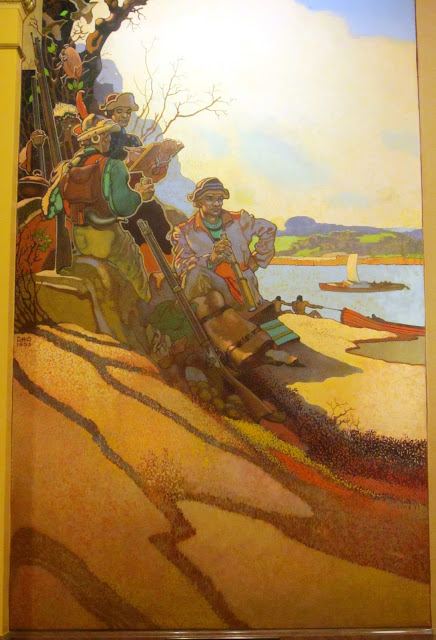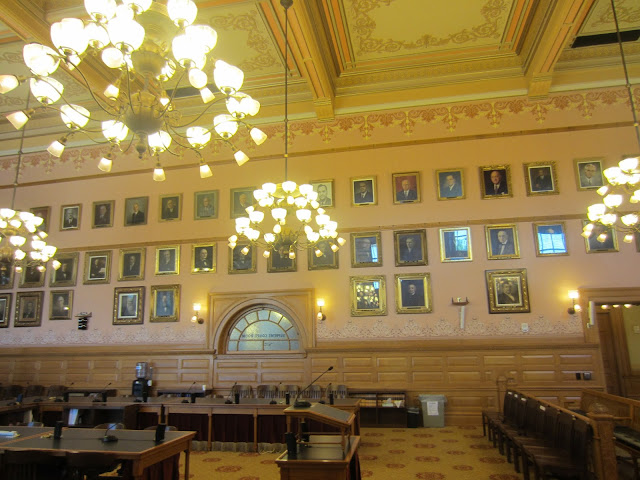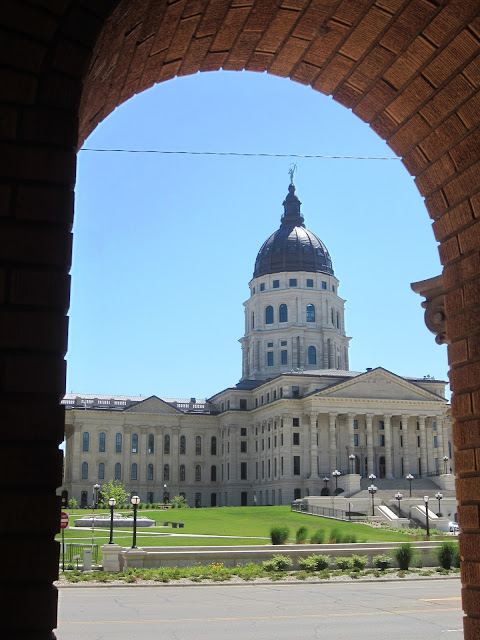Topeka, Kansas, was our third state capital in a week, and the capitol building, along with the one in Lincoln, Nebraska (see post here), and Des Moines, Iowa (see posts here and here), was one of the most beautiful we've seen. It has the classic majestic exterior known to those who are familiar with the US Capitol. At 304 feet, this dome is actually taller than the 288-foot-tall US Capitol dome, but its 50-foot diameter is about half of the US Capitol's 96 feet. It has the look of a rocket ready for launch.
Construction took 37 years, and the capitol was declared finished in 1903. In 1901, a proposal had been submitted for a sculpture of Ceres, goddess of agriculture, to "complete" the tower. Controversy over the cost and the pagan subject (and her questionable morals) prevented the statue from ever being cast and installed. It wasn't until 1984 that the process for selecting a new design began. The winner of the competition was a sculptor named Richard Bergen, whose design was a Native American warrior shooting an arrow at the sky:
While funds were being raised to pay for the sculpture, the cupola had to be reinforced so that it could hold the 4,420-pound, 22-foot-tall figure. Before it was installed, the finished sculpture was driven 3,000 miles to 35 cities around the state in the back of a truck so that Kansans could see and touch it. It was 2002 before the sculpture was finally lifted in place by a huge crane: |
| Photo from here |
Surprise, surprise! A copy of the Statue of Liberty graces the capitol grounds. This is the third or fourth one we've seen at a capitol.
 |
| The Coming of the Spaniards in 1561 (Coronado was the first European explorer to visit what would become Kansas. I love the sunflowers in this painting.) |
 |
| The Chisholm Trail (The trail used by Texas cattlemen to get their stock to the Kansas railheads) |
 |
| Arrival of the Railroad, 1859-1860 (Find the sunflowers) |
 |
| Westward Ho (More sunflowers!) |
 |
| Lewis and Clark (In 1804, Lewis and Clark passed through what would become the northeast corner of Kansas) |
 |
| Building a Sod House |
 |
| Battle of Mine Creek, 1864 (The second largest cavalry battle of the Civil War. It ended with a victory for the Union Army.) |
The engineering behind the free-floating stairs is really interesting:
I love the minute, ornate detail, something rarely seen in today's streamlined, sleek interiors:
The second floor rotunda is lined with some of Kansas's native heroes sculpted by Peter Felten. First is aviation pioneer Amelia Earhart (1897-1937):
White was called "the Sage of Emporia" and won the 1923 Pulitzer Prize for his 1922 editorial "To an Anxious Friend."
The final statue is of Arthur Capper (1865-1951), who served as Governor of Kansas from 1915 to 1919 and then as a Republican US Senator from 1919 to 1949.
 |
| Symbols of Kansas--cattle, a wheat field, a grain elevator, fields of corn and grain. |
 |
| A Kansas farmer with his wife and children |
My favorite mural is this one of John Brown, a gun in his right hand a a copy of the Bible in his left, the Union and Confederacy squaring off behind him.
The mural represents a period of violence called "Bleeding Kansas" that occurred in 1854 after the Kansas-Nebraska Act stated that residents could determine whether an area would become a free state or slave state. Pro- and anti-slavery activists flooded into Kansas trying to influence the decision, and before long the battle got ugly. Abolitionist John Brown was there to lead the anti-slavery faction.Here's a bit of trivia: This is the only state capitol that features a person convicted of treason.
We ran into this friendly, familiar face in one of the hallways. He hardly looks like a man who could command millions of soldiers and order massive attacks that killed thousands, does he?
A peak into the Governor's office revealed a stuffed pheasant in flight:
Our next stop was the Kansas Supreme Court Room:
Current and former Justices scrutinize visitors from their places on the courtroom wall:
The chandeliers remind me of UFOs:
Above us, angels painted on ceiling panels were reading books, probably to escape the boredom of the proceedings below:
I'd say that overall the Representatives have it pretty good. Take a look at the carpet, for example. Gorgeous.
We've discovered that the library in capitols is often the most stunning room in the building:
The Kansas State Library was another winner:
One more reminder of the state flower:
Next, the Senate Chamber:
It is just as stunning as the House of Representatives chamber:
There are lots of ornate details:
The "Senate Gallery" is another name for the balcony, and this time only gentlemen are not allowed to wear their hats. (Apparently it's okay for women--and maybe even male ruffians--to wear their hats.)
Looking down at the Senate Chamber from the Gallery:The Kansas State Motto, ad astra per aspera, means "Through hardships to the stars":
Even the BATHROOM in the Kansas Capitol is posh:
We went higher and higher inside the dome:

This mural represents Power. It shows a woman with a sword in her hand, a Spanish-American soldier in brown on her right and a Civil War Union soldier in blue on her left:
This mural shows Knowledge reading a book in the center with Temperance on her right and religion on her left:
I do like how all the figures, except for the soldiers, are women. This artist knew who makes things happen in the world.
The sunflower is the state flower of Kansas. I was so entranced by the sunflower images incorporated all over the capitol that at the end of our visit I purchased a hand-painted sunflower necklace in the gift shop. I loved taking home that bit of Kansas!
The Kansas State Capitol is definitely an A+ destination.























































Nice. I loved the hammered copper throughout. I'm kind of surprised Bob Dole did not have a noticeable presence in the building. And the sunflowers are very nice.
ReplyDeleteI love the beautiful paintings and murals. Another lovely capitol building!
ReplyDelete